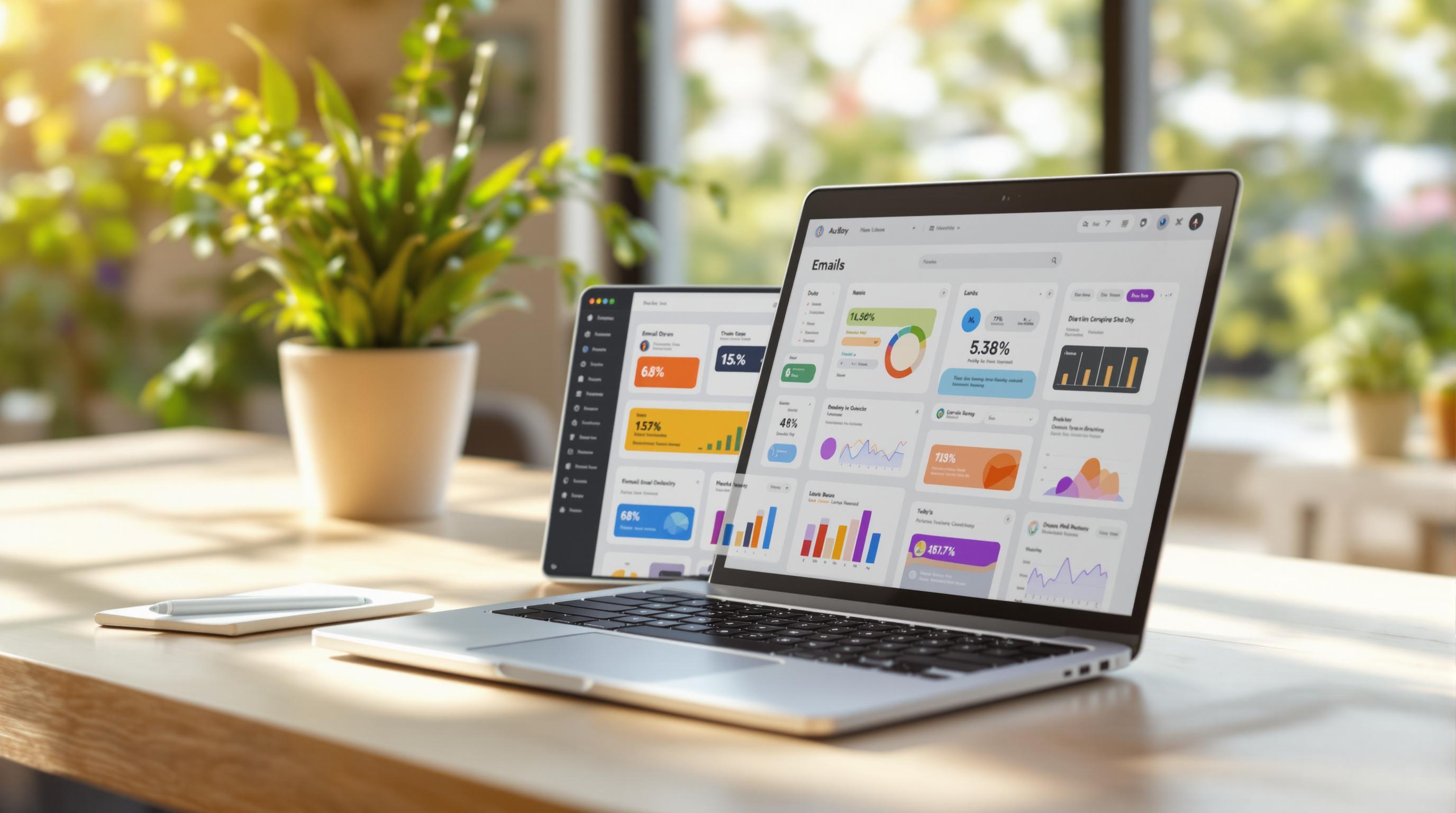AI-driven market segmentation helps small and medium-sized businesses (SMEs) target customers more effectively by analyzing data like purchase history, online behavior, and demographics. Unlike manual methods, AI automates the process, identifies smaller customer groups, and adjusts in real time as customer behaviors change. For SMEs, this means more precise marketing, better resource allocation, and scalable solutions as their customer base grows.
Key Highlights:
- What It Is: AI uses machine learning to group customers into specific segments based on shared traits and behaviors.
- Why It Matters for SMEs: Saves time, reduces costs, and improves marketing results by automating complex processes.
- Popular Tools: HubSpot, Mailchimp, Klaviyo, Sprout Social, and Google Analytics 4.
- How to Start: Audit your data, define clear goals, integrate tools, and train your team to act on insights.
- Best Practices: Keep data updated, start with broad segments, and regularly review performance.
AI-powered segmentation is a practical way for SMEs to create personalized campaigns, improve customer engagement, and grow efficiently with limited resources.
Basics of AI-Driven Customer Segmentation | Exclusive Lesson
AI Tools for Market Segmentation
AI is reshaping how small and medium-sized enterprises (SMEs) approach market segmentation. From specialized analytics platforms to all-in-one marketing suites, these tools bring a range of features that help businesses better understand their customers. The key is finding solutions that balance advanced capabilities with ease of use and affordability.
Most modern AI segmentation tools come equipped with features like automated customer clustering, predictive analytics, real-time data processing, and seamless integration with existing systems. Many also include visual dashboards, which simplify complex data for non-technical users - a major advantage for SMEs without dedicated data science teams. These tools play a crucial role in helping businesses make informed decisions about their customer strategies.
Best AI Tools for SMEs
Several AI-powered platforms are particularly effective for market segmentation in SMEs. These tools demonstrate how AI empowers smaller businesses to execute highly targeted marketing strategies.
- HubSpot's Marketing Hub: This tool uses machine learning to automatically segment contacts based on behaviors, engagement levels, and demographics. It enables businesses to create highly personalized campaigns with minimal manual effort.
- Mailchimp's Advanced Segmentation: Mailchimp analyzes purchase patterns, engagement, and browsing behavior to create segments like "frequent buyers", "at-risk customers", and "seasonal shoppers." Many businesses report improved campaign performance with these tailored audience groups.
- Klaviyo: Tailored for e-commerce businesses, Klaviyo tracks customer lifecycle stages and predicts future buying behavior. It helps businesses identify loyal customers and those at risk of churning, so they can adjust their communication strategies accordingly.
- Sprout Social: For businesses focused on social media, Sprout Social offers AI-driven audience analysis. It segments followers based on engagement, interests, and demographics, helping businesses determine what type of content resonates most with their audience.
- Google Analytics 4 (GA4): GA4 provides advanced segmentation features at no extra cost. By leveraging machine learning, it identifies user segments based on behaviors and engagement, making it a powerful tool for businesses already using Google’s advertising ecosystem.
Finding Tools with AI for Businesses

To simplify the search for AI tools, platforms like AI for Businesses serve as directories that help SMEs explore and evaluate solutions across different business functions, including market segmentation. This directory includes options like Looka, Rezi, Stability.ai, and Writesonic, all designed to enhance various business processes.
AI for Businesses offers pricing tiers ranging from free access to premium plans with advanced features and dedicated support. The platform focuses specifically on SME needs, avoiding overwhelming users with solutions designed for large enterprises. Each tool listing provides detailed information about features, pricing, integration options, and user reviews, helping businesses make informed decisions.
With its search and filtering tools, the directory allows users to find solutions based on budget, industry, or specific functionality. This streamlined approach makes it easier for SMEs to compare and select the tools that best suit their needs.
How to Choose the Right Tool
Choosing the right AI segmentation tool involves weighing several factors. While budget is important, the cheapest option may not always be the best long-term choice. Consider the total cost of ownership, including setup fees, training, and integration costs.
Data integration is another critical factor. A good segmentation tool should connect seamlessly with your existing systems, such as your CRM, e-commerce platform, email marketing software, or social media accounts. Without this, the tool’s effectiveness may be limited.
Ease of use is especially important for SMEs with limited technical resources. Look for tools with intuitive interfaces, detailed documentation, and trial periods to test functionality before committing.
Scalability is another key consideration. As your business grows, your chosen tool should be able to handle larger datasets and more complex segmentation needs. Review pricing structures and potential feature limitations to ensure the tool can evolve with your business.
Lastly, robust reporting and analytics features are essential. The right tool should provide clear insights into segment performance, campaign results, and ROI through visual dashboards and automated reports. These features help teams manage their segmentation strategies efficiently, even with limited time and resources.
How to Implement AI-Driven Market Segmentation
Implementing AI-driven market segmentation can feel overwhelming, especially for small and medium-sized enterprises (SMEs). The key is to approach it step by step, starting with a solid foundation in data preparation. Many businesses make the mistake of jumping straight into advanced features without first addressing the basics. By breaking the process into manageable steps and aligning it with your business goals, you can set yourself up for success.
Step-by-Step Implementation Guide
Start with a data audit and preparation.
Before diving into AI tools, take a close look at your customer data. Pull information from your CRM, website analytics, email campaigns, and social media. Clean up the data by removing duplicates, standardizing formats, and filling in missing details. The quality of your data directly impacts the accuracy and usefulness of your segmentation.
Define your segmentation objectives.
Be clear about what you want to achieve. Are you trying to reduce churn? Increase average order value? Improve email engagement? Having specific goals will help you focus on the right data points and make sense of the AI-generated segments.
Integrate your tools with relevant data sources.
Connect your AI tool to your CRM, e-commerce platform, and email systems. This might involve setting up API connections or uploading CSV files, depending on the tool. The goal is to create a comprehensive view of your customers' behaviors and interactions.
Establish initial segments based on your business logic.
While AI can uncover hidden patterns, it’s helpful to start with segments that align with your existing business model. Group customers by factors like purchase frequency, engagement level, or lifetime value. These initial segments act as a useful framework for interpreting AI insights.
Train your team to interpret AI insights.
Your team needs to understand how to read and act on segmentation reports. Focus on actionable insights and translate them into strategies that can drive results.
Develop targeted campaigns for each segment.
Once your segments are ready, craft tailored campaigns for each group. Customize your messaging, offers, and communication frequency to suit the needs of each segment. Test different approaches and track performance to see how AI-driven segmentation compares to broader, less-focused strategies.
By following these steps, SMEs can implement AI-driven segmentation effectively, creating targeted marketing strategies that lead to sustainable growth.
Best Practices for Success
Once your segmentation framework is in place, these practices can help you maintain and improve its effectiveness over time.
Keep your data clean and up-to-date.
AI relies on accurate data, so establish routines for cleaning and monitoring your datasets. Set up alerts for anomalies that could signal integration issues or inconsistencies.
Start simple and scale gradually.
Begin with a few broad segments rather than overcomplicating things with micro-segmentation. As you gather insights and see how customers respond, you can refine and subdivide your segments for more precise targeting.
Regularly review segment performance.
Monitor key metrics like conversion rates, engagement, and revenue contributions for each segment. If a segment isn’t performing as expected, revisit your strategy to see if adjustments are needed.
Combine AI insights with human expertise.
AI can reveal patterns in your data, but your team’s market knowledge is just as important. If a segment seems counterintuitive, dig deeper instead of dismissing it outright.
Document segment details and strategies.
Keep records of each segment’s characteristics, the campaigns designed for them, and the performance benchmarks you’re aiming for. This ensures consistency across your team and provides a reference for future campaigns.
Common Mistakes to Avoid
Over-segmenting your audience.
Creating too many narrow segments can dilute your marketing efforts. Focus on a manageable number of segments that you can effectively target and measure.
Ignoring segment size.
A tiny segment might have interesting traits, but if it’s too small, it may not justify the resources needed for a dedicated campaign. Always weigh the potential return on investment.
Failing to update segments.
Customer behavior and market trends change over time. Review and refresh your segments regularly to stay aligned with seasonal shifts and evolving preferences.
Inconsistent messaging across channels.
Ensure your segments are applied consistently across all platforms, from email campaigns to social media and website personalization. A unified message strengthens your brand and improves results.
Expecting instant results.
AI-driven segmentation takes time to show its full potential. Allow a few months for data collection, segment validation, and campaign optimization.
Skipping integration planning.
Poor planning can lead to incomplete customer profiles, which undermines your segmentation efforts. Map out your data flows early and address integration challenges upfront.
sbb-itb-bec6a7e
Case Studies: AI Segmentation Success Stories
Small and medium-sized enterprises (SMEs) across a variety of industries are leveraging AI-driven market segmentation to sharpen their marketing strategies. By using this approach, businesses can better target their audiences, leading to more impactful campaigns.
Before and After Results
SMEs that have adopted AI segmentation often see impressive transformations in their marketing outcomes. Some of the most common benefits include:
- Higher engagement rates in digital marketing campaigns.
- Improved conversion rates thanks to personalized messaging.
- Reduced customer acquisition costs paired with stronger customer retention.
These results highlight how AI-powered segmentation can open doors to better performance and measurable business growth, setting the stage for its application across different industries.
Examples by Industry
AI segmentation has proven effective in numerous sectors, each with unique challenges and opportunities:
- E-commerce: Retailers use AI to refine audience targeting, driving higher engagement and increasing average order values.
- SaaS companies: By identifying customer segments, these businesses reduce churn and encourage faster adoption of new features.
- Food and beverage: Brands personalize offers and content to cater to varied customer tastes, resulting in better subscriber retention and satisfaction.
- Fitness industry: Personalized workout recommendations based on individual goals help boost user retention and loyalty.
- Professional services: Firms segment their prospects to better understand client needs, enabling tailored onboarding experiences and more effective support.
These examples show how a data-driven approach to segmentation can transform marketing strategies, helping businesses grow while staying competitive in their respective markets. AI-powered tools are proving to be a game-changer for organizations looking to connect with their audience in a meaningful way.
Key Takeaways for SMEs
After diving into AI tools and their practical applications, small and medium-sized enterprises (SMEs) are well-positioned to tap into the advantages of AI-powered market segmentation. What was once exclusive to large corporations is now within reach for businesses of all sizes, offering tangible results in today’s data-driven world.
Benefits of AI Market Segmentation
AI-driven market segmentation opens the door to tailored customer experiences and measurable returns. By delivering personalized content and offers at just the right time, businesses can see higher conversion rates and deeper customer engagement. This targeted approach not only boosts customer loyalty but also allows SMEs to scale their efforts efficiently without ballooning costs.
Another major advantage is continuous data processing. AI tools can keep strategies fresh and relevant, enabling SMEs to adapt quickly to changing market conditions. This adaptability is a crucial asset in competitive environments, making AI a powerful tool for businesses looking to grow strategically.
Next Steps for SMEs
To harness these benefits, it’s essential to start small and build strategically. Begin with a focused pilot project. Before diving in, audit and clean your existing data to identify what you have and where the gaps are. This foundation ensures that your AI tools can work effectively from the start.
Select one specific customer segment for your pilot project. This allows you to test the technology, gather insights, and refine your strategy without overwhelming your resources. When choosing AI tools, prioritize those that integrate seamlessly with your current systems to minimize disruptions during the rollout.
Equipping your team with the right skills is equally important. Many AI platforms provide training resources and ongoing support to help businesses get the most out of their tools. Partnering with providers that offer guidance can make the transition smoother and more productive.
For SMEs unsure where to begin, platforms like AI for Businesses offer curated directories of AI tools tailored for smaller enterprises. These resources can help you find segmentation tools that align with your budget and technical capabilities.
As you implement AI, establish clear key performance indicators (KPIs) to track your progress. Metrics like engagement rates, conversion rates, and customer acquisition costs can reveal what’s working and where adjustments are needed. Regular analysis will not only help optimize your strategy but also demonstrate the value of your investment.
Lastly, keep an eye on emerging AI trends and best practices. The field evolves quickly, and staying informed can help your business maintain an edge over competitors who may lag behind. This proactive approach ensures you’re ready to adapt and thrive in a rapidly changing landscape.
FAQs
How can small businesses prepare their data for AI-powered market segmentation?
To get your data ready for AI-driven market segmentation, small businesses should prioritize accuracy and consistency. Begin by conducting regular data audits to catch and fix any errors or outdated information. It's also a good idea to set clear standards for data entry, such as consistent formatting and naming rules, to keep everything uniform across your datasets.
Another key step is organizing your data into meaningful categories while eliminating duplicates or irrelevant entries. This minimizes errors that could throw off your AI models and ensures your segmentation results are more precise and useful. When your data is clean and well-structured, your AI tools can provide insights that are better aligned with your business goals.
What should SMEs look for when choosing an AI tool for market segmentation?
When choosing an AI tool for market segmentation, small and medium-sized businesses should prioritize tools equipped with advanced features like psychographic and behavior-based analysis. These tools should also include real-time data processing and predictive analytics to help anticipate customer needs and improve targeting.
It's also important to consider how well the tool integrates with your current systems. A user-friendly interface can make adoption much smoother for your team. Another valuable feature to look for is micro-clustering, which allows you to group customers based on specific behaviors, such as their purchase history or browsing patterns. This level of detail can take personalization to the next level, making your marketing campaigns more effective.
How can small and medium-sized businesses (SMEs) evaluate the success of AI-powered market segmentation?
SMEs can measure the success of AI-driven market segmentation by keeping an eye on a few important metrics. Key performance indicators (KPIs) like return on investment (ROI) from marketing campaigns, customer engagement rates, and conversion rates offer a clear picture of how well AI tools are delivering results.
Beyond these, signs of improvement in product-market fit and the impact of personalized marketing strategies are also valuable benchmarks. By digging into these metrics, businesses can gauge how AI insights are helping them connect with their target audience and fine-tune their marketing efforts effectively.


